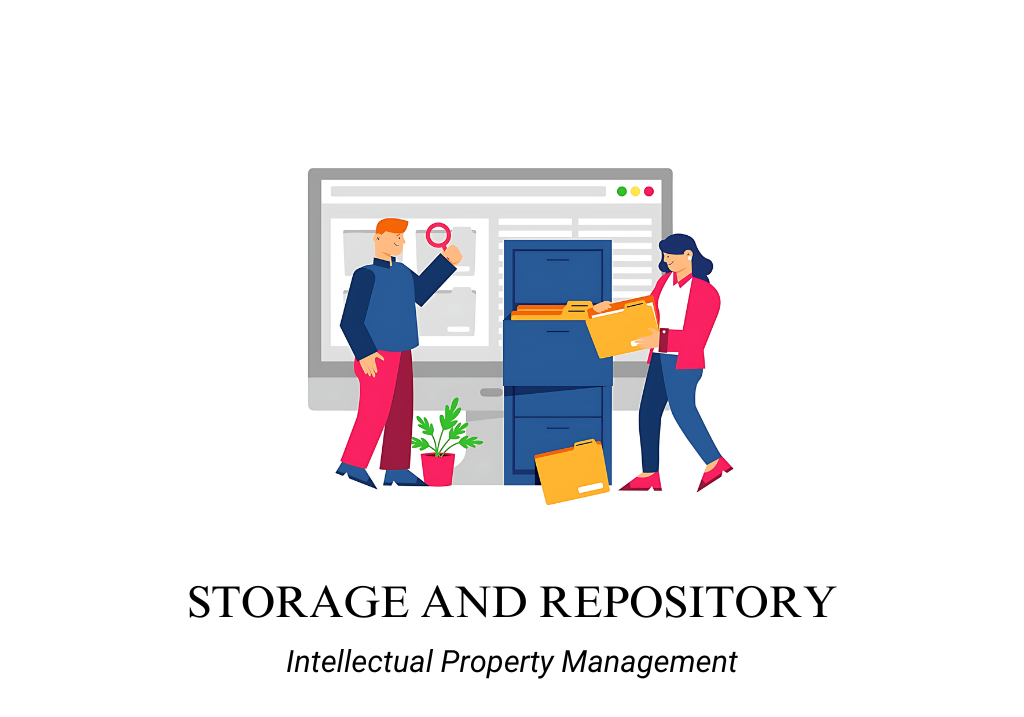Introduction
Meaning
Storage and repository functionality in intellectual property (IP) management involves the systematic organization, storage, and retrieval of IP-related documents and data. This functionality ensures that all IP assets, such as patents, trademarks, copyrights, and associated legal documents, are securely stored in a centralized location, where they can be easily accessed, categorized, and managed. Effective storage and repository management is crucial for maintaining a well-organized and secure IP portfolio.
Purpose
The purpose of storage and repository functionality is to provide a secure, centralized platform for managing and accessing all IP-related information. This functionality enables organizations to efficiently store, categorize, and control access to their IP assets, ensuring that important documents are both easily retrievable and protected from unauthorized access. By organizing and securing IP data, organizations can enhance their IP management processes, streamline workflows, and ensure compliance with legal and regulatory requirements.
Benefits
- Centralized Data Management: Provides a single location for storing all IP-related documents, making it easier to manage and retrieve critical information.
- Improved Organization: Categorization and tagging features ensure that IP assets are well-organized and easily searchable, reducing time spent locating documents.
- Enhanced Security: Accessibility controls and access audits help protect sensitive IP information, ensuring that only authorized individuals can access or modify documents.
- Compliance and Accountability: Access audit trails provide a record of who accessed or modified documents, supporting compliance with legal and regulatory requirements.
- Increased Efficiency: Streamlines IP management processes by making it easier to find, organize, and manage IP assets, ultimately saving time and reducing administrative overhead.
CHECK MORE: Guide to find best Intellectual Property Management Tools for Lawyers
Features
Centralized Repository
Meaning:
A centralized repository is a feature that consolidates all IP-related documents, data, and files into a single, unified storage system. This repository serves as the central hub for all IP assets, including patents, trademarks, copyrights, legal agreements, and related documentation.
Purpose:
The purpose of a centralized repository is to simplify the management and retrieval of IP information by storing all relevant documents in one location. This feature eliminates the need for multiple storage systems, reducing the risk of data loss and ensuring that all IP assets are easily accessible when needed.
Use Cases:
- IP Portfolio Management: An organization uses a centralized repository to store and manage its entire IP portfolio, ensuring that all patents, trademarks, and related documents are securely stored and easily retrievable.
- Legal Document Storage: A law firm centralizes its IP-related legal documents, contracts, and correspondence in a single repository, improving document management and retrieval efficiency.
Categorization and Tagging
Meaning:
Categorization and tagging is a feature that allows users to organize IP assets by assigning them to specific categories and adding descriptive tags. This helps in organizing and classifying documents based on various attributes, such as type of IP, jurisdiction, filing date, or associated project.
Purpose:
The purpose of categorization and tagging is to enhance the organization and searchability of IP assets within the repository. By categorizing and tagging documents, users can quickly locate relevant information, streamline their workflows, and ensure that IP assets are organized according to the organization’s specific needs.
Use Cases:
- Document Management: A company categorizes its IP documents by type (e.g., patents, trademarks) and tags them with relevant keywords (e.g., “renewal,” “infringement”) to facilitate quick searches and efficient document retrieval.
- Project-Based Tagging: An R&D team tags IP assets associated with specific projects, making it easier to track and manage the IP related to particular innovations or products.
Accessibility Control
Meaning:
Accessibility control is a feature that manages and restricts access to IP assets stored in the repository. This feature allows administrators to set permissions, ensuring that only authorized users can view, edit, or share specific documents or data.
Purpose:
The purpose of accessibility control is to protect sensitive IP information by ensuring that access to documents is restricted based on user roles and permissions. This feature helps prevent unauthorized access or alterations to critical IP assets, thereby maintaining their integrity and security.
Use Cases:
- Role-Based Access: A multinational corporation uses accessibility control to restrict access to certain IP assets based on employee roles, ensuring that only relevant personnel can access sensitive information.
- Confidential IP Protection: An organization implements strict accessibility controls on highly confidential IP assets, such as trade secrets, to prevent unauthorized access or leaks.
Access Audit
Meaning:
Access audit is a feature that tracks and records all access to IP assets within the repository. This includes logging who accessed, viewed, edited, or shared documents, along with the date and time of access.
Purpose:
The purpose of an access audit is to maintain a transparent and accountable record of all interactions with IP assets. This feature is crucial for ensuring compliance with legal and regulatory requirements, providing an audit trail that can be reviewed to identify unauthorized access or other suspicious activities.
Use Cases:
- Compliance Monitoring: A company uses access audit logs to monitor compliance with internal policies and external regulations, ensuring that sensitive IP data is accessed only by authorized personnel.
- Incident Investigation: Following a potential data breach, an organization reviews access audit logs to determine if any unauthorized individuals accessed sensitive IP documents, helping to identify the source of the breach.
Conclusion
These functionalities and its features are essential for maintaining an organized, secure, and compliant IP management system, ensuring that all IP assets are properly stored, managed, and protected throughout their lifecycle.
CHECK OUT IP MANAGEMENT TOOLS ON DIRECTORY OR CLICK HERE


